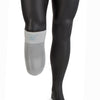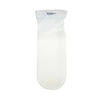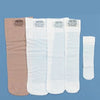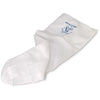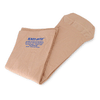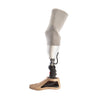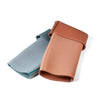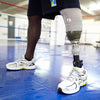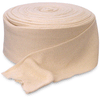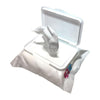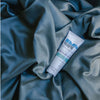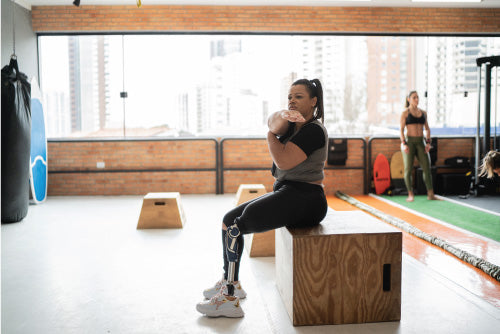The Complete Guide to Prosthetic Stump Socks
A prosthetic stump sock is a specialized component of nearly all prosthetic systems. Socks for amputees are manufactured using really expensive knitting machines designed to create everything from a 3D rounded toe area to fleeced interior and many other sock features that are unique to prosthetics. Prosthetic stump socks are manufactured for all amputation types ranging from a symes amputee to a hemi-pelvectomy amputation. Stump socks have really evolved over the past 15 years as a result of new technology available in the textile industry. In years past, prosthetic socks were primarily used as a vehicle to control socket volume and provide cushion against a socket constructed from willow wood. Nowadays, socks are available with specialized fibers for wicking perspiration or fighting odor causing bacteria. Many manufacturers now offer prosthetic socks impregnated with mineral oil gel to enhance skin preservation and provide cushion for your residual limb.
Ultimately, the primary reason for using prosthetic socks is to maintain a "snug fit" of your prosthetic limb. When a prosthesis becomes loose it begins to feel heavy and opens the door to friction related blister or worse yet, ulcers. When your Prosthetist takes a cast impression of your residual limb, he or she is fabricating your prosthesis using a mold of your residual limb at its current size and shape at that point in time. The body is constantly in-flux and adjusting itself to the environment. After your morning coffee, the diuretic effects of caffeine will change the shape of your limb requiring you to add sock ply. Because your socket has a specific volume that may not always match your residual limb, the difference is accommodated with prosthetic stump socks of various sock ply or thicknesses. Common "ply counts" are 1(Lightweight), 3 and 5-Ply thicknesses. All sock materials have different properties and react differently when used with a prosthesis. A 5 ply wool sock may "feel" thicker and provide more cushion than a lycra/cotton mix and as a result not all 3-Plys are exactly equal in thickness.
TIP: It's a good idea to use a stump shrinker at night to maintain your residual limb within a volume range.
Typically when you receive a prosthesis your insurance carrier allows for a starter supply of stump socks, usually 6-12 prosthetics socks in total of various thicknesses and styles. It's always advantageous to build a prosthetic sock supply greater than a health insurance's allotment so that you have more socks of various plies at your disposal. Your leg may fit in the morning with a 3 Ply sock, however by the time lunch rolls around your socket is starting to feel loose. A loose fitting socket may introduce friction and reek havoc on your residual limb's skin. Not to mention, a prosthetic socket that is really loose can create leg length issues, feel heavy and create excessive pressure over boney areas. Many prosthetic users will carry with them a small "on-the-go" prosthetic sock supply for mid-day sock ply adjustments.
Determining the correct sock ply count is mixture of user experience and experimentation. What felt comfortable at 7am may feel inadequate by 10:30am. It's usually suggested by Prosthetists to begin by adding 1-Ply or "filler socks" to your sock mix in increments of one sock until your prosthetic socket feels comfortable again. Once you've added (3) filler socks you may want to consider swapping out those three filler stump socks for one 3-Ply prosthetic sock. Some experienced prosthetic users immediately experiment with thicker 3 or 5-Ply socks and scale up or down depending upon the many factors that affect socket fit.
A few sock manufacturers introduced "half socks" that accommodate looseness in the lower portion of your prosthetic socket. Residual limbs for many do not shrink and swell uniformly. It's not uncommon for below knee amputees to experience greater volume fluctuations around the calf area versus their knee joint. Some amputees have gone as far as cutting their 3 or 5-Ply socks into half socks . Most stump socks will not unravel, however it is strongly suggested by sock manufacturers not to cut your stump socks .
Mismanaging sock ply count with too little or too many prosthetic socks can easily ruin what was seemingly going to be a great day. Read here for prosthetic sock best practices in sock ply management.
At what prosthetic sock ply count is it time to throw the towel in, or in this case your sock and say enough is enough. A prosthetic sock ply count of 20-Ply may be considered by many amputees as excessive. However, the spectrum truly ranges due to individual needs, amputation level and degree of limb maturation. Some people wear a prosthesis with 15-20-Ply socks without issue because their sockets feel uniformly snug. However, when it feels impossible to attain a uniformly tight socket fit, your socket rotates when walking or bending your knee in a movie theater is a challenge, your sock ply count can be considered excessive. Read about using prosthetic gel in the interim while you await an appointment with your Prosthetist.














































